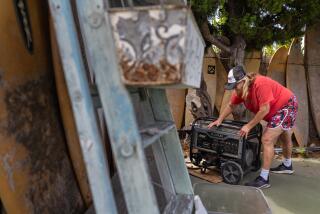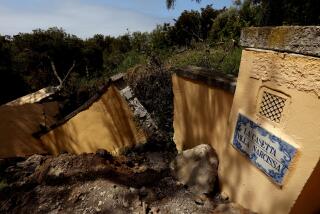American Dream Becomes a Nightmare : Home ownership: An El Segundo couple’s $290,000 investment is sinking before their eyes. They say an old oil sump is to blame.
Jim Frazier believed that he and his wife, Caryl, had bought a piece of the American dream in 1988, when they purchased their first home, a three-bedroom, two-bath house in El Segundo, complete with a family room and a large yard.
Today, the Fraziers, who have a 3-year-old daughter and a year-old son, say their $290,000 American dream has become a nightmare.
The problem, they say, is that the house is sinking into an abandoned oil sump, a pit used years ago to collect overflow from a nearby oil well, which is no longer operating.
“Right now,” said Frazier, “we can’t sell this place, we can’t refinance it, we can’t rent it.”
Frazier’s first inkling of trouble came last fall, when the 38-year-old airline employee noticed that cracks had begun appearing in the house’s walls and its cement patio. A month later, recalling how the sellers of the house had mentioned that they would fix a crack in the family room floor, Frazier pulled up the wall-to-wall carpet and found a 31-foot semi-circular crack across the cement slab floor.
That was when he got the sinking feeling, he said, that a lot of people knew what he has since learned--that his house is probably settling into the old oil sump.
“My house is breaking in half. There’s an old oil well back there,” Frazier said, pointing to a neighbor’s back yard, “and everybody knows what’s going on and they’re running for the hills.”
Frazier said his insurance company dug eight to 10-foot holes in his yard in an effort to explain the sinking. “Oil was dripping down the sides of the holes like a hot fudge sundae,” he said.
The insurance company, however, refused to cover the damage to the house, claiming the problem stemmed from earth movement that was not covered by the couple’s policy.
Likewise, Chevron Oil Co., which owns the underground oil and natural gas rights in the neighborhood, told Frazier the company bears no responsibility because the nearby well was built by another oil company.
In May, Frazier filed suit against the previous owners, Nancy and Rick Brown, and against the real estate agent who handled the sale, Robert H. MacKay, all of El Segundo. In the suit, filed in Torrance Superior Court, Frazier claims the seller and realtor failed to fully disclose the damage to the house and its causes.
Contacted this week, Rick Brown referred all inquires to his attorney, who could not be reached for comment. MacKay, whom Frazier described as a once-close friend, could not be reached for comment either.
But in an interview, Nancy Brown asserted that a root from a neighbor’s tree cracked the cement slab under the family room. She said neither she nor her husband knew anything about an oil sump in the area.
“We had no idea that (there) was oil underneath the ground at all. . . . We had no idea that our house had problems like this,” she said. Brown also expressed regret about the legal action. “We were all friends and Bob was a friend of (the Fraziers) too, and he was just trying to help them get a house,” she said.
Frazier contends that when he and his wife first toured the house, Caryl Frazier noticed an irregularity underfoot in the family room. At the time, Frazier said, Rick Brown said the cause was a tree root and promised that the crack would be repaired before closing the sale.
Today, the back end of Frazier’s house has sunk so much that beams are pulling out of the walls. “If we get a good little jolt, it could all come down,” Frazier said.
There is water damage in the family room and in a bedroom--the result of gaps left in the roof as the house sinks, Frazier said.
“When you pay $290,000 for a house and you come home at night and the rain’s pouring in . . . ,” he said, his voice trailing off.
Frazier has spent most of the past year piecing together the story behind the sinking of his house. He poured over public documents in City Hall and other agencies and talked extensively with neighbors and former residents of the area, some of whom he traced as far away as New Hampshire.
They all told him the same story, he said, that there had been an oil well in the area before the tract houses were built, and that in the 1930s--when oil wells in the area were dug--they were accompanied by sumps. Today, sumps, or overflow pits, are illegal, according to David Sanchez, petroleum engineer and spokesman for the Division of Oil and Gas in the state Department of Conservation.
Waste and overflow must go into tanks and the tanks have to have bermed areas around them, Sanchez said.
Local regulations, Sanchez said, required that abandoned sumps be filled in with heavily compacted material so that anything built on top of them would not sink.
Frazier said former neighbors told him that during the time the Browns owned the house, a concrete block wall in the back yard was replaced with a wooden fence because the block wall had sunk so much it had large gaps in it.
However, Nancy Brown said this week that the wall was damaged because a tree in a neighbor’s yard had been leaning against it.
Frazier said his case is bolstered by a letter he found in City Hall files. The letter, written in 1970 by a previous owner of the house, asks the city to send an inspector to determine why her back yard was sinking. Frazier also produced a copy of a 1974 building permit showing that, despite the complaint four years earlier, the city allowed the owner to add a family room and bathroom to the back of the house.
Frazier and his attorney said they believe ultimate responsibility for the damage to the home--and to a neighbor’s home that also appears to be sinking--lies with an oil company, the city and the insurance company that refused to cover costs stemming from the damage.
However, Frazier said, he cannot afford the kind of legal fees it would take to sue a public agency and large corporations: “I’m not trying to make money. I’m just trying to get back as near to whole as possible and get out.”
Frazier’s lawyer, Phillip G. Samovar said: “We have filed a limited action but, perhaps, there’s a bigger issue as to what’s happening out there environmentally.”
More to Read
Inside the business of entertainment
The Wide Shot brings you news, analysis and insights on everything from streaming wars to production — and what it all means for the future.
You may occasionally receive promotional content from the Los Angeles Times.









